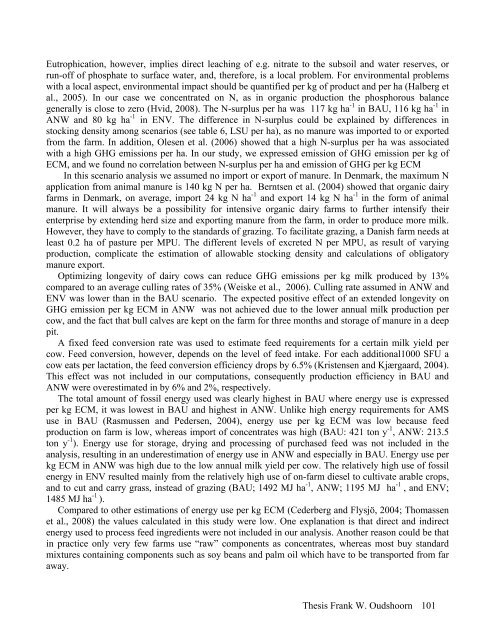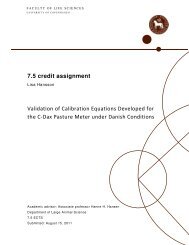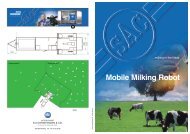Innovative Technology and Sustainable Development of Organic - 1.
Innovative Technology and Sustainable Development of Organic - 1.
Innovative Technology and Sustainable Development of Organic - 1.
You also want an ePaper? Increase the reach of your titles
YUMPU automatically turns print PDFs into web optimized ePapers that Google loves.
Eutrophication, however, implies direct leaching <strong>of</strong> e.g. nitrate to the subsoil <strong>and</strong> water reserves, or<br />
run-<strong>of</strong>f <strong>of</strong> phosphate to surface water, <strong>and</strong>, therefore, is a local problem. For environmental problems<br />
with a local aspect, environmental impact should be quantified per kg <strong>of</strong> product <strong>and</strong> per ha (Halberg et<br />
al., 2005). In our case we concentrated on N, as in organic production the phosphorous balance<br />
generally is close to zero (Hvid, 2008). The N-surplus per ha was 117 kg ha -1 in BAU, 116 kg ha -1 in<br />
ANW <strong>and</strong> 80 kg ha -1 in ENV. The difference in N-surplus could be explained by differences in<br />
stocking density among scenarios (see table 6, LSU per ha), as no manure was imported to or exported<br />
from the farm. In addition, Olesen et al. (2006) showed that a high N-surplus per ha was associated<br />
with a high GHG emissions per ha. In our study, we expressed emission <strong>of</strong> GHG emission per kg <strong>of</strong><br />
ECM, <strong>and</strong> we found no correlation between N-surplus per ha <strong>and</strong> emission <strong>of</strong> GHG per kg ECM<br />
In this scenario analysis we assumed no import or export <strong>of</strong> manure. In Denmark, the maximum N<br />
application from animal manure is 140 kg N per ha. Berntsen et al. (2004) showed that organic dairy<br />
farms in Denmark, on average, import 24 kg N ha -1 <strong>and</strong> export 14 kg N ha -1 in the form <strong>of</strong> animal<br />
manure. It will always be a possibility for intensive organic dairy farms to further intensify their<br />
enterprise by extending herd size <strong>and</strong> exporting manure from the farm, in order to produce more milk.<br />
However, they have to comply to the st<strong>and</strong>ards <strong>of</strong> grazing. To facilitate grazing, a Danish farm needs at<br />
least 0.2 ha <strong>of</strong> pasture per MPU. The different levels <strong>of</strong> excreted N per MPU, as result <strong>of</strong> varying<br />
production, complicate the estimation <strong>of</strong> allowable stocking density <strong>and</strong> calculations <strong>of</strong> obligatory<br />
manure export.<br />
Optimizing longevity <strong>of</strong> dairy cows can reduce GHG emissions per kg milk produced by 13%<br />
compared to an average culling rates <strong>of</strong> 35% (Weiske et al., 2006). Culling rate assumed in ANW <strong>and</strong><br />
ENV was lower than in the BAU scenario. The expected positive effect <strong>of</strong> an extended longevity on<br />
GHG emission per kg ECM in ANW was not achieved due to the lower annual milk production per<br />
cow, <strong>and</strong> the fact that bull calves are kept on the farm for three months <strong>and</strong> storage <strong>of</strong> manure in a deep<br />
pit.<br />
A fixed feed conversion rate was used to estimate feed requirements for a certain milk yield per<br />
cow. Feed conversion, however, depends on the level <strong>of</strong> feed intake. For each additional1000 SFU a<br />
cow eats per lactation, the feed conversion efficiency drops by 6.5% (Kristensen <strong>and</strong> Kjærgaard, 2004).<br />
This effect was not included in our computations, consequently production efficiency in BAU <strong>and</strong><br />
ANW were overestimated in by 6% <strong>and</strong> 2%, respectively.<br />
The total amount <strong>of</strong> fossil energy used was clearly highest in BAU where energy use is expressed<br />
per kg ECM, it was lowest in BAU <strong>and</strong> highest in ANW. Unlike high energy requirements for AMS<br />
use in BAU (Rasmussen <strong>and</strong> Pedersen, 2004), energy use per kg ECM was low because feed<br />
production on farm is low, whereas import <strong>of</strong> concentrates was high (BAU: 421 ton y -1 , ANW: 213.5<br />
ton y -1 ). Energy use for storage, drying <strong>and</strong> processing <strong>of</strong> purchased feed was not included in the<br />
analysis, resulting in an underestimation <strong>of</strong> energy use in ANW <strong>and</strong> especially in BAU. Energy use per<br />
kg ECM in ANW was high due to the low annual milk yield per cow. The relatively high use <strong>of</strong> fossil<br />
energy in ENV resulted mainly from the relatively high use <strong>of</strong> on-farm diesel to cultivate arable crops,<br />
<strong>and</strong> to cut <strong>and</strong> carry grass, instead <strong>of</strong> grazing (BAU; 1492 MJ ha -1 , ANW; 1195 MJ ha -1 , <strong>and</strong> ENV;<br />
1485 MJ ha -1 ).<br />
Compared to other estimations <strong>of</strong> energy use per kg ECM (Cederberg <strong>and</strong> Flysjö, 2004; Thomassen<br />
et al., 2008) the values calculated in this study were low. One explanation is that direct <strong>and</strong> indirect<br />
energy used to process feed ingredients were not included in our analysis. Another reason could be that<br />
in practice only very few farms use “raw” components as concentrates, whereas most buy st<strong>and</strong>ard<br />
mixtures containing components such as soy beans <strong>and</strong> palm oil which have to be transported from far<br />
away.<br />
Thesis Frank W. Oudshoorn 101




